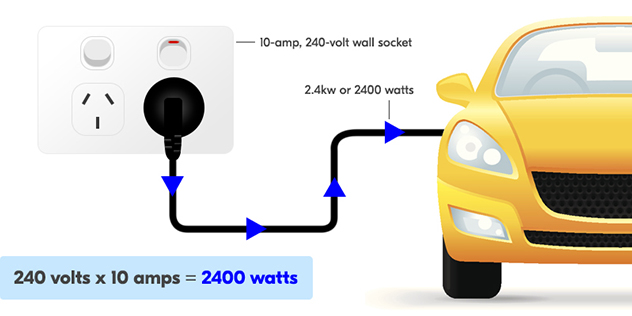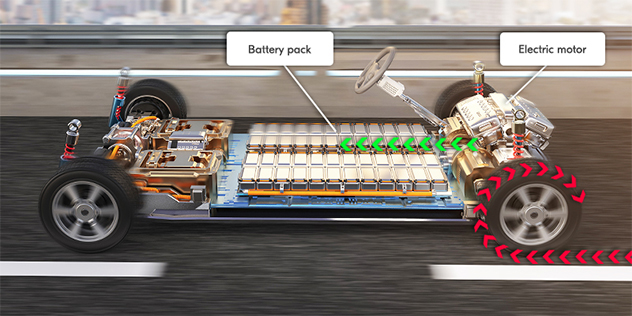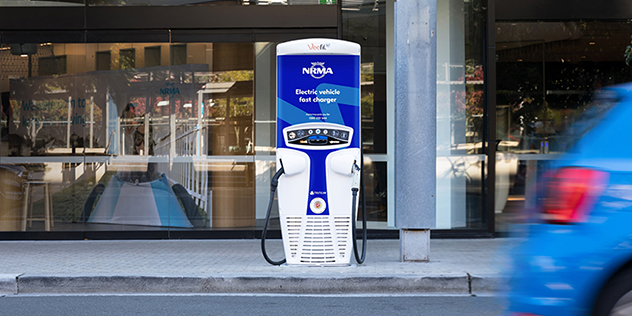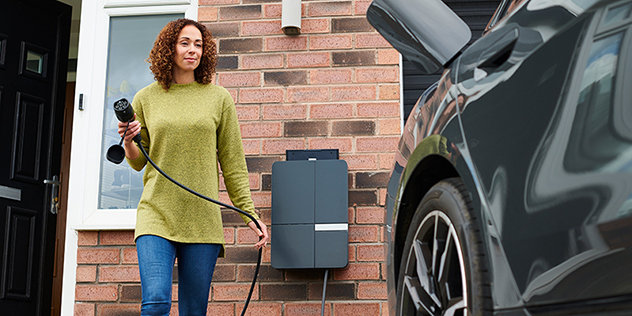The EV glossary: Clearing up common electric vehicle terms

Entering the world of electric vehicles (EVs) can seem intimidating. However, getting to know the terms commonly used when discussing EVs can help make the process of learning about them less daunting and more enjoyable.
So, from common EV terms, to technical units of measurement and even slang, here is the EV glossary.
What's in here:
Alternating current (AC) | Amps (A) | Battery capacity | Battery pack | Charge rate | Direct current (DC) | Driving range | Electric motors | Electric vehicle (EV) | EPA | Fast charging | ICE and ICE’d | Kilowatt (kW) | Kilowatt-hour (kWh) | NEDC | Onboard charger-inverter | Plug types | Regenerative braking | State of Charge (SoC) | State of Health (SoH) | Vehicle-to-grid (V2G) | Vehicle-to-home (V2H) | Vehicle-to-load (V2L) | Wall box | WLTP
Alternating current (AC)
Alternating current – AC for short – is the type of power that runs our electrical grid, homes and most appliances we use.
All electric cars use direct current (DC) in their operation, meaning AC power needs to be changed to DC before it can charge an electric car.
In an EV application, AC is seen in two situations: when describing the charge rate an AC-power-fed home charger can output; and the maximum amount of AC power an EV’s onboard charger-inverter can process. More on charge rates and onboard charger-inverters soon.
Amps (A)
In the simplest practical terms when discussing EVs, an amp (A) can be considered a multiplier of voltage to determine power in watts.
This is most important when determining the output of home chargers, including wall box chargers. The calculation for charge rate through a standard home wall socket might look like:

Here, we see that a charging cable plugged into a 10-amp, 240-volt wall socket could output 2400 watts, or 2.4kW to an EV.
Battery capacity
When we talk about battery capacity, we’re referring to the amount of energy an EV’s onboard battery pack can store – the most common unit of measurement for this being kWh.
The larger this figure, the more energy the battery can store, which generally means better driving range and performance figures, but also increases the time it takes to be recharged.
As we see an increase in EVs offering vehicle-to-grid and vehicle-to-load capability, battery capacity will become an even more important buying consideration.
Battery pack
An EV’s onboard battery pack is a cluster of cells used to store electrical energy. Lithium-ion (Li-ion) is the most common style of battery chemistry seen – also featuring in laptops and mobile phones.
When an EV’s accelerator is pushed, this high voltage battery pack forms a circuit with its electric motor(s) to accelerate the vehicle. Under deceleration, charge can be sent back into the battery pack via regenerative braking.

Image: Illustration of regenerative braking
While battery packs are necessary for an EV to drive (and some other functions), a standard 12-volt lead acid battery is also installed for simpler functions. Unlike these standard 12-volt batteries, an EV’s battery pack operates at a very high voltage and cannot be serviced at home or by standard mechanics.
Charge rate
Charge rate, generally measured in kW, refers to the amount of power a charger can send into an EV’s battery pack.
As charge rate increases, the time it takes to charge the EV typically decreases. The charge rate you have access to should also be factored in when deciding on an EV. Think of the process like filling a bucket: to reach the brim sooner, we can either increase flow from the tap or use a smaller bucket.
Direct current (DC)
DC refers to direct current. This type of current flow is standard across EV battery packs.
Fast chargers also output DC, meaning they can transfer power directly into an EV without it needing to be inverted by the EV’s onboard charger, unlike an AC charger.
The result of this is higher, more efficient charge rates and faster charging.
Driving range
When talking EVs, driving range is simply how far the vehicle can travel on a single charge.
There are three main standards for EV range measurement: NEDC, WLTP, and EPA testing.
NEDC ( New European Driving Cycle) is an 40-year-old standard stipulated for use by Australian Design Rule 81/02 that does not reflect real-world driving conditions accurately. It has significant discrepancies between tested and real-world performance, mainly due to its low testing parameters and narrow temperature range. The values determined by NEDC do not match today's driving profiles.
WLTP (Worldwide Harmonized Light Vehicles Test Cycles)is the newest and most accurate test standard, providing a more realistic representation of driving conditions. It includes various driving situations, longer distances, and stricter conditions. WLTP tends to show lower range and energy efficiency compared to NEDC due to its more realistic conditions.
The US-based EPA (Environmental Protection Agency)'s testing standards provide fuel economy estimates for the country's automotive market. The EPA mandates car manufacturers to update their fuel economy values on fuel economy labels. The EPA conducts tests for various driving conditions. The EPA's fuel economy tends to display lower, and more realistic, values than WLTP. However, there is a tendency to use WLTP as a common reference point in Australia.
Many things can negatively affect an EV’s actual driving range, such as high cruising speeds, aggressive acceleration, cold climates and using milder regenerative braking modes.
Electric motors
Electric motors are a crucial part of an EV’s powertrain, as they are what drives the vehicle’s wheels and make it move.
Basically large magnets, electric motors generate turning force when current is sent through them from an EV’s battery pack. Electric cars can have anywhere from one electric motor, all the way up to three in some high-end performance models.
Just like an internal combustion engine vehicle, the more energy sent to these electric motors, the faster the acceleration – and the faster you’ll end up on empty.
Electric vehicle (EV)
EV means electric vehicle – a term which encompasses any and all vehicles that utilise electricity to move. While ‘electric vehicle’ and ‘electric car’ are often used synonymously, this is incorrect. Not just referring to cars, EVs can include electric scooters, boats, trains and even planes, so long as they use electrical energy to move.
Beyond that, not all 'electric cars' run only on electricity. There are also differing forms of hybrid electrified cars:
- Battery electric vehicles (BEVs) run purely on electricity;
- Plug-in hybrid vehicles (PHEVs) can typically drive around 80-100km on pure electric power and have a combustion engine for longer distances;
- Hybrid electric vehicles (HEVs) must use petrol (but can sometimes drive a few kilometres using electric power from the small battery).
We’ve covered all you need to know on the different types of EVs here, and broken down the pros and cons of buying a BEV, PHEV or HEV here.
Fast charging
Fast charging – or a fast charger – typically refers to an EV charger outputting 50kW or more of charge rate.
Given the limitations of circuitry in residential buildings, this 50kW-and-above charge rate is only seen with DC technology in dedicated commercial or public charging infrastructure, such as the NRMA’s electric vehicle fast charging network.

Image: NRMA electric vehicle charging station at Sydney Olympic Park
ICE and ICE’d
Between our own electric car reviews and the growing number of EV communities out there, you may have seen the term ICE or ICE’d thrown around.
ICE stands for internal combustion engine, which is any engine that relies on the combustion of a fuel in a chamber to produce energy. This includes petrol, diesel, LPG and, in some cases, even hydrogen.
To be ICE’d means to have an internal combustion engine vehicle block an EV from accessing a charger. Unfortunately, this is just one of many faux pas when it comes to proper charging etiquette.
Kilowatt (kW)
A kilowatt (kW) represents 1000 watts and is the most common metric used to measure power.
When it comes to EVs, we typically see kW used in two instances: the maximum power output of a vehicle’s electric motor(s); and to measure charging rate.
Kilowatt-hour (kWh)
Things get a little technical when explaining kilowatt-hour (kWh), despite the term being seen all the way from new EV model specifications to your home power bill.
Unlike kW – which is an instantaneous measurement of power – kWh is energy capacity, or power over time.
Because of this, we use kWh to measure the capacity of battery packs in EVs. The larger this kWh figure, the more energy the EV can store.
Breaking down kWh for EVs to its most basic details goes like this: charging an EV with a 10kW charge rate for one hour will result in 10kWh of energy being moved into its battery. Or, the other way around: A 10kWh battery can output 10kW of power for one hour.
Onboard charger-inverter
Every EV has what’s known as an onboard charger, with many also containing an inverter. The role of the onboard charger-inverter is to control the amount and type of energy entering the battery, while also monitoring overall battery conditions such as temperature and state of charge.
Many EV battery packs have limited charge rates, and it is the onboard charger’s job to restrict this. This means an EV with a 50kW max charge rate plugged into a 350kW charger won’t suffer any battery damage, as the onboard charger will only allow up to 50kW of energy to flow into the battery.
As mentioned above, EV battery packs store and discharge DC, however many chargers – including almost all home EV chargers – operate using AC. The onboard charger-inverter’s job is to turn AC electricity into DC before it enters the battery. The bulky box on your laptop’s charging cable does much the same thing.
Bear in mind, some energy is lost during this AC-to-DC conversion, meaning 10kW of AC charge rate will not fill a battery as fast as 10kW DC will.
Plug types – Type 1, Type 2, CCS Combo 1, CCS Combo 2, CHAdeMO, Tesla and GB/T
Over the relatively short history of mainstream electric cars, many brands have tried their hand at coming up with the perfect plug type. The result of these initiatives has been a frustrating mix of different charging plugs (and EV charging ports designed to accept them) that are all but incompatible with each other.
When you hear terms like CCS or CHAdeMO thrown around, it’s referring namely to the shape of the plug that connects to the vehicle – however the differences between these can have a big effect. Different electric vehicle plug types The industry is thankfully moving towards more standardised plugs, but until then, we’ve explained every EV plug type here for those wanting a deeper dive into the properties of each.
Regenerative braking
Remember above when we said electric motors are basically magnets that take energy from a battery pack and convert it into turning force? Regenerative braking is the exact reverse of this: taking the turning force of an EV in motion, using this to create electrical charge, and sending it back into the battery.
All modern EVs have some form of regenerative braking, with many offering different modes or ‘aggressions’ of the feature. The more aggressive, the more the car will recharge its battery, however the more rapid the deceleration will be.
Some EVs, such as the Volvo XC40 Recharge use regenerative braking in a way where drivers don’t even need to touch the brake pedal in most instances.
State of Charge (SoC)
Think of an EV’s State of Charge (SoC) as the fuel gauge on an ICE vehicle.
Measured between 0 and 100 per cent, the SoC refers to remaining charge in a battery pack and is crucial information for EV drivers both on the road and at chargers. SoC is displayed in clear sight on an EV’s dashboard.
State of Health (SoH)
State of Health (SoH) indicates...well, how healthy the battery of an EV is.
Measured between 0 and 100 per cent, the SoH refers to remaining capacity in a battery pack. Because lithium-ion batteries degrade over time, this measurement indicates how much driving range an EV is capable of compared to when it was new. It can be important to find this out when buying a secondhand EV, although data shows that EV batteries do last longer than most people think.
Vehicle-to-grid (V2G)
Vehicle-to-grid (V2G), also known as ‘bi-directional charging’ technology is not new, but is slowly gaining popularity among EV makers.
V2G allows an EV to both receive and send power to the grid – or home – it is plugged into. The technology shows great promise, effectively allowing slack in the energy grid to be taken up by EVs plugged into chargers at homes and workplaces.
There’s also the added benefit of your EV becoming a mobile home battery, able to power the house in case of a blackout.
Vehicle-to-home (V2H)
Vehicle-to-home (V2H) allows an EV to power a building by connecting the car to the electricity circuit via an inverter. The battery in an EV stores 4-5 times the energy used by a typical home on a daily basis, so in theory it could a be useful way of storing solar energy during the day and using it at night.
Though not yet viable in Australia due to the price of the inverters that can do this, and because changes need to made to standards that control how a vehicle can "talk" to the home circuit, experts expect this to become possible in the near future.
Vehicle-to-load (V2L)
Vehicle-to-load (V2L) allows an EV to send electricity back out through its charging port, however at a much smaller rate than V2G.
V2L has so far been marketed for the powering of appliances – think TVs, fridges, air conditioners at the campsite – and is not designed to run an entire house.
As more EVs receive tow ratings and are used for family camping trips, this technology will come into its own. The most cumbersome item on camping trips is often a generator or portable battery pack, so why lug one around when you could just drive there in it?
Wall box
A wall box is a dedicated EV charger fitted to a home or workplace. Generally using AC power, the wall box allows homes and businesses access to much higher charge rates not possible via a standard wall socket power point.
Also trickling into the market now are DC wall boxes – able to take the DC produced by solar panels and feed it directly into an EV. This is an interesting space to watch.

For those wanting a more technical deep-dive on wall boxes and all things related to charging your EV at home, check out our comprehensive guide to EV home charging.
Heard of any other unfamiliar EV terms or jargon? Join our EV community forum today and let us know what other terms should be added to the list.


